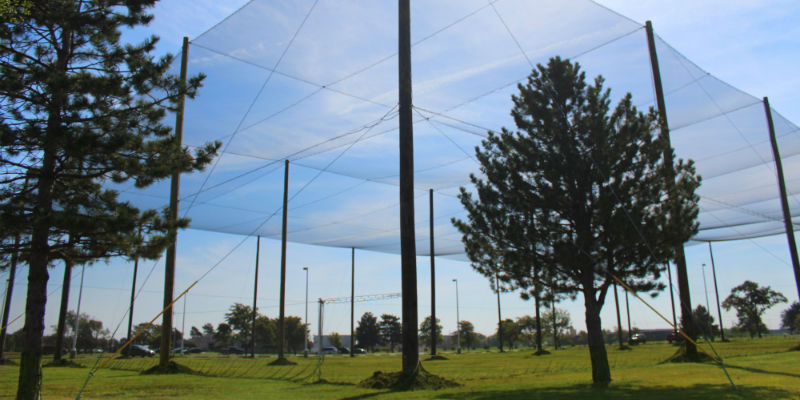
This photo provided by Kansas State University Polytechnic Campus shows the school’s new drone testing pavilion for unmanned aircraft systems (UAS). (Courtesy of Kansas State University Polytechnic Campus via AP)
Researchers at Kansas State University’s Salina campus have found a unique solution to testing drones in a real-world environment while maintaining safety: They built a very big cage.
The Federal Aviation Administration has severe restrictions on where drones can fly outdoors, including a prohibition within five miles of an airport. The college’s campus happens to fall within such a five-mile radius. So, since the school started an unmanned aircraft program in 2008, flights have had to occur offsite.
The 300-foot long, 200-foot wide and 50-foot tall netted structure looks a bit like a fully-enclosed golf driving range. The nets — held up by wooden utility poles — allow the wind, rain, snow or other weather conditions to easily pass into the test area and don’t block GPS signals. That means that researchers can test the drones in lifelike situations without risking safety.
Unmanned aircraft promise to change numerous businesses and public safety functions. Electric companies want them to inspect miles of remote power lines. Farmers want them to survey land or find bugs or soil that is too dry or lacking nutrients. Insurance companies want them to assess damage after a disaster. And firefighters want them to help battle wildfires.
The quickly-growing industry hasn’t yet developed sophisticated collision-avoidance systems or found ways for the aircraft to navigate without human help.
And day after day there is another report of people flying their drones where they aren’t supposed to, like near the White House. The Federal Aviation Administration now receives about 100 reports a month from pilots who say they’ve seen drones flying near planes and airports, compared with only a few sightings per month last year.
Kansas State University’s new drone testing pavilion shows the creative — but also cumbersome — steps that those trying to advance the use of unmanned aircraft face.
Filed Under: Aerospace + defense




